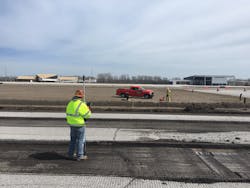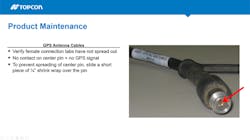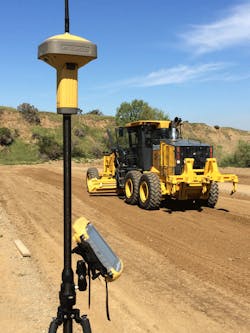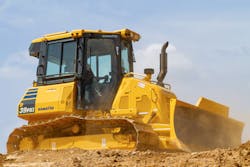Be Self Reliant with Machine Control Repair
Today’s machine control systems have come a long way from their predecessors—the bolt-on components from third-party providers like Topcon, Trimble, and Leica are now far more rugged (and well connected, thanks to plug-and-play engineering), and from-the-factory integrated systems feature in-machine and in-cylinder components that are never exposed to job site hazards.
But that doesn’t mean managers are off the hook. However obscure, component wear and the need for recalibration, as well as the possible need for system updates, can come into play.
And on the integrated systems, like those from Caterpillar and the more branded efforts, such as Intelligent Machine Control from Komatsu and SmartGrade from John Deere, telematics systems can alert owners in the event of an issue.
“Integrated systems not only offer customers improved durability and advanced logic for elevated productivity, but they are also integrated into the telematics and error-code/health-reporting capabilities that are in the base machine,” says Jason Anetsberger, senior product manager with Komatsu.
“For example, on a Komatsu machine, if there is an issue with the health of the technology, the operator will be alerted right on the display in the cab. System and sensor performance are constantly monitored,” Anetsberger says. “Additionally, on an integrated system like ours, the machine’s technology and sensor health can be reported remotely to the customer’s office or equipment manager.”
Integrated from the factory, or added to a machine later, the common link is that most of the care and maintenance of machine-control components can easily be done in the field or handled by a manufacturer’s warranty.
“We warranty the integrated systems the same as our machines,” Anetsberger says. “It’s an integrated system on the machine so we offer the same comprehensive warranty as the machine itself. Extended warranties, repair and maintenance plans, etc., are all offered for the integrated systems with the machines.”
For added-on, or third-party components, there are two primary categories when you look at maintenance, says John Dice, director of professional services for Topcon Positioning Systems.
“I’m seeing machine control as encompassing all types of systems, including 2D systems and 3D systems,” Dice says. “So one category would be wear items and the long-term things that happen to them, and the second would be updating equipment.”
What items wear with machine control?
“Keep in mind we all bolt our stuff to machinery that moves around and bangs and jars, and also the things we’re controlling and cutting with, like blades, do wear,” Dice says.
First, consider cables. “You can imagine on a dozer that a cable that goes up to a receiver, a GPS antenna, or a laser sensor,” Dice says. “Those can be maintenance items because they are sometimes taken on and off on a regular basis; you’re screwing threads on. That would be one of the biggest things that customers need to keep a close eye on—the integrity of cables.
“You’re commonly not going to be fixing those, but basically making sure the connections are tight and secure,” Dice says. “Also, watch them for wear and pinching items. Make that part of your machine walk-around.”
On a motor grader, be aware of the rotation sensor, which is a mechanical part that bolts on top of the hydraulic swivel in the center of the circle.
“When the operator rotates the blade, there are two mechanical parts that turn on top of each other,” Dice says. “There’s also a little potentiometer in there that turns, but the potentiometer’s not an issue. On an annual basis, a good practice is to find the four little screws, take it apart, clean the base and the groove out, and re-apply some grease back in there and put it back together,” Dice says.
The grease is not for lubrication, Dice says, but rather for filling a void. “The purpose of the grease filled into the groove is to keep dirt and moisture from getting inside of that piece, and to keep it mechanically secure. Use marine grease and fill it in.”
Another possible maintenance item is a sonic tracker.
“The original sonic tracker that Topcon invented many years ago has a transducer in the bottom,” Dice says. “It’s not that far off from what old Polaroid cameras used; a little sonic sensor that measured the distance to focus. It sends out sound waves, they bounce off a physical reference and come back, so they measure the distance to a surface.
“We put them on asphalt pavers, on profilers, and on motor graders, and you would use the tracker, for example, to keep the cutting edge at a certain depth below the lip of curb,” Dice says. “So it’s a non-contacting device that measures down, bounces off the curb and comes back, and controls the cutting edge to the depth-of-curb. It can also track a stringline.”
Depending on the job site and the type of work being performed, the transducer can be rendered ineffective.
“Specifically in an asphalt environment, the fumes and stuff can build up on the transducer and it will get to where it can’t ‘hear’ anymore,” Dice says. “It will send out the sound wave and it will come back, but it’s clogged up and it really can’t hear very well, so it doesn’t work.
“Customers don’t always know that it can be cleaned,” Dice says. “So that sensor can be turned over for cleaning. Just use mild soap and water; don’t use harsh chemicals like diesel or contact cleaner. Just spray it up in there and slosh it around, and you’re good to go. In a worst-case scenario where it won’t come clean, it’s a field-replaceable item you can replace in just a few minutes right on the job site.”
“We’re attaching systems to a dozer, a motor grader, then what are they doing? They’re going out and cutting dirt,” Dice says.
“We’re controlling the depth of the device, be it a laser system, or a GPS system, a slope system, and we’re measuring to the cutting edge. As we grade, the cutting edge wears out. The sensors are not changing, but the thing they’re attached to is changing.”
Because of wear, the calibration to the cutting edge needs to be checked and is another maintenance item that can and should be done on the job site, according to Dice.
Anetsberger agrees. “Whether it’s a factory-installed system, a rover, or an aftermarket 3D machine control system, we always recommend that customers check their GNSS equipment and site infrastructure each morning by benching in—confirming accuracy—on a known point on the job site. Similarly, on integrated systems or aftermarket ones, operators should check their cutting edges on dozers or teeth on excavators for significant wear, and enter the measurement into the machine,” he says.
“There are two things,” Dice says. “On a GPS system, it’s that vertical measurement, so you’re checking the wear on the cutting edge. On a regular basis, you’re going to want to measure and verify that the elevation is correct. On a slope-control system, if you’re cutting a 2-percent slope, you’re grading along, you want to make sure it’s 2 percent. We recommend that somebody check it every day.
“One way is simply to go to work,” Dice says. “Let’s say you’re cutting a street section, so when you’re grading this pass, you’re cutting along at a 2-percent slope, then what you do is after you’ve graded for 100 feet or 200 feet, turn around and go right back over top of the spot that you just cut. And if you were grading at 2-percent slope in one direction, when you turn around and go back, you would now be cutting a minus 2-percent slope. The point is, it should match itself. You have verified that the slope system is calibrated.”
Contrarily, if the operator finds that they are a half-inch off, a field recalibration is necessary. “In five minutes, you can actually adjust it yourself,” Dice says.
“On a 3D system, we say you should check the elevation every day,” Dice says. “If you have a job designed for a 3D system on your motor grader, here’s a way you can know if it’s actually right or not.
“When you start a job, typically close to where you park the machines or where you’re working, have a couple of spots set up somewhere in the dirt where you can...set the cutting edge down on that position and just verify the elevation,” Dice says.
Use the job’s grade-setter to help the process.
“It could be a hub that the grade-setter sets with the survey rover,” Dice says. “So now I’ve got somewhere for my blade to be able to set down and verify that it’s correct. So that’s Step 1. What I always encourage people to do, too, is also check the grade behind the machine. Because you don’t want to be cutting for a few hours and then find out that oh, crap, the thing was wrong. And that’s the grade-setter’s job. When they’re getting started in the morning, the operator’s out here cutting grade. The grade-setter’s job every day ought to be to walk up behind the machine check several spots behind the machine with that survey rover and verify the machine is cutting the right grade.
“But that was just a static check to verify that it’s okay,” Dice says. “Using GPS-position measurements, if I set it down on that little hard piece of dirt and I check in my number, and there’s actually a little position check button on our control box where you can set it down, you go to position check, boom, you’ve verified grade,” Dice says. “When you do that position check, if it’s within a tenth of a foot, go to work.”
If there’s an error, the culprit could be blade wear.
“Now if the elevation is off, if that cutting edge wears out, you can imagine what’s going to happen,” Dice says. “The grade-setter comes behind the machine, he’s checking, and he finds you’re 5 hundredths high, you’re 8 hundredths high, you’re 7 hundredths high—we’re off by an average of 6 or 7 hundredths of a foot.”
In this case, pull a tape measure and check the cutting edge.
“When our cutting edge is worn out, you simply type in an adjustment measurement and then you’re off and running again,” Dice says. “You’re just resetting that measurement that you’ve taken. There’s a button on the Topcon screen that is called ‘blade wear.’ So you just go to blade wear, it says my cutting edge should be 35 hundredths, and now it’s only 3 tenths, you can just simply re-enter that new number and you’re off and running.”
Just like a smartphone, some machine control systems require updates.
Machine control systems must be updated
“We would suggest that periodically you update the software on your equipment,” Dice says. “Most of this has to do with 3D machine control. Very commonly it’s something that our dealer goes out and does or sends to the customer because they may not have [the connection] to do it over the air. This means they’d have to take a USB stick with the updated software and plug it in. It’s something a customer can do in most cases.
“They are available on our website; we have a My Topcon website where customers can go and get software. Be it firmware for GPS receivers to software that goes on the control boxes, we commonly update our software a couple of times a year,” Dice says. “Many times it’s minor little things, like we get a new receiver or we add capabilities. We would encourage customers to have their equipment updated annually. It doesn’t always happen; we’ve got customers that have been running for many years never updating equipment and they’re fine. But there are feature enhancements that might be nice to take advantage of.”
Machines that are running off laser transmitters run the risk of having the laser’s positioning function become inaccurate, particularly if the laser is bumped or comes in contact with hard surfaces like the bed of a pickup truck. “Customers don’t always know that they can check accuracy right in the field and make an adjustment with almost any laser in the world,” Dice says.
“So you go up to cut a dead flat pad or set forms for concrete and you want a 2-percent slope, but how do you know that it’s right?” Dice says. “You can set up your laser, set it up to dead flat, you take your stick, you walk a couple hundred feet, take a measurement, rotate the transmitter 90 degrees; go each side, 90 degrees. You put your measurement stick a couple hundred feet away in the same position, then if you go back to your laser transmitter and rotate it 90 degrees it’s going to shut off and re-level. When it re-levels, it should be coming back to the same position every time. You’re checking all four sides of the laser and that’s all there is to it—people don’t understand that they can check it. It’s simple to do. It’s just education. Open up your manual and you can probably figure it out and do a field calibration in about 15 minutes.”



